BSBMGT617 Develop & Implement Business Plan: ETPL Case Study
VerifiedAdded on 2023/04/23
|27
|5441
|237
Project
AI Summary
This assignment presents a detailed business plan for Ethical Training Proprietary Limited (ETPL), a vocational education company focused on providing ethical training to retail sector employees to minimize employee theft. The plan includes an analysis of the market, potential customers, and competition, along with pricing strategies and marketing activities. It outlines the company's operational planning, staffing, and key personnel, as well as a SWOT analysis and future goals. The plan also covers financial projections, funding requirements, and performance monitoring strategies, with the aim of providing a comprehensive roadmap for ETPL's success in the Australian market.

Running head: BUSINESS PLAN
Business Plan
Name of the Student:
Name of the University:
Author Note:
Business Plan
Name of the Student:
Name of the University:
Author Note:
Paraphrase This Document
Need a fresh take? Get an instant paraphrase of this document with our AI Paraphraser
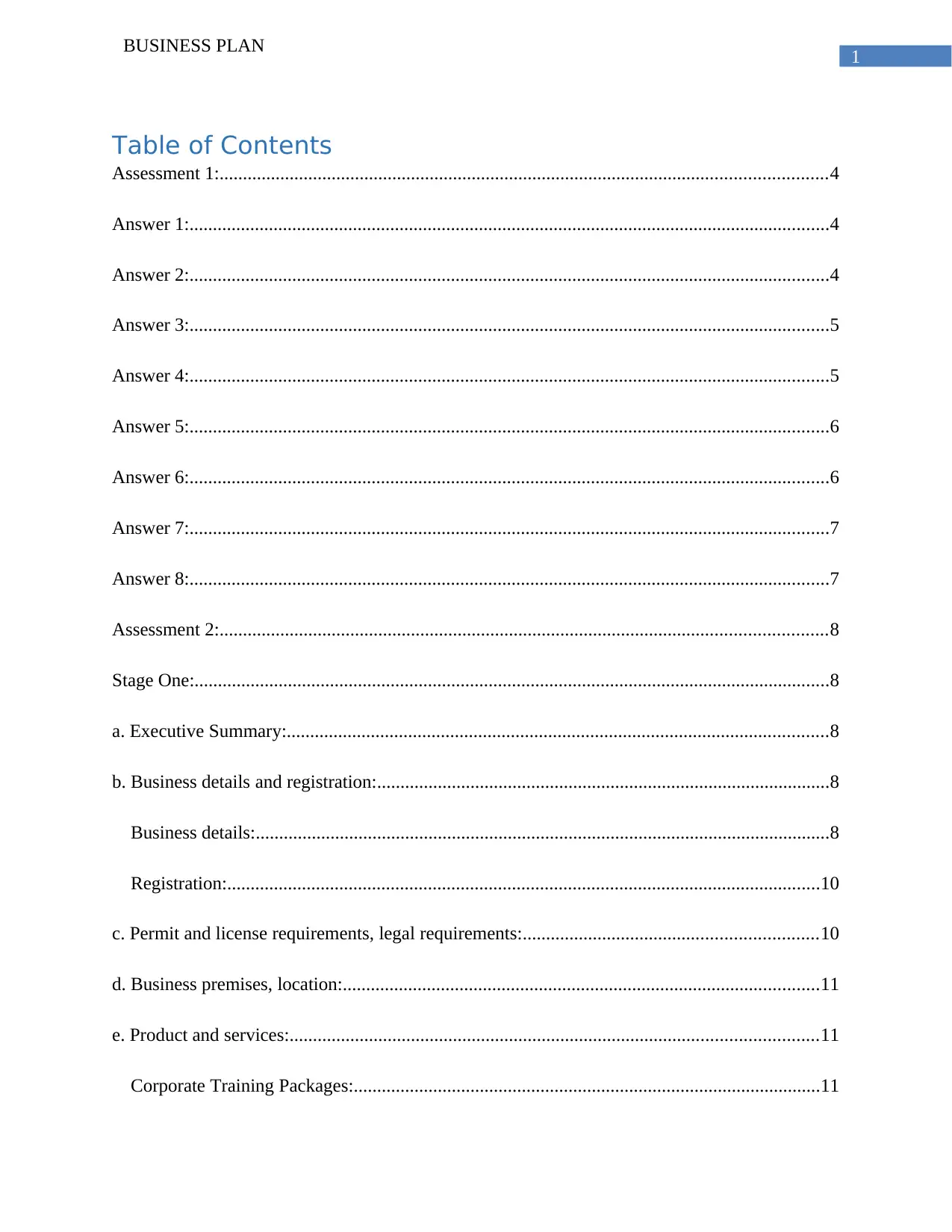
1
BUSINESS PLAN
Table of Contents
Assessment 1:..................................................................................................................................4
Answer 1:.........................................................................................................................................4
Answer 2:.........................................................................................................................................4
Answer 3:.........................................................................................................................................5
Answer 4:.........................................................................................................................................5
Answer 5:.........................................................................................................................................6
Answer 6:.........................................................................................................................................6
Answer 7:.........................................................................................................................................7
Answer 8:.........................................................................................................................................7
Assessment 2:..................................................................................................................................8
Stage One:........................................................................................................................................8
a. Executive Summary:....................................................................................................................8
b. Business details and registration:.................................................................................................8
Business details:...........................................................................................................................8
Registration:...............................................................................................................................10
c. Permit and license requirements, legal requirements:...............................................................10
d. Business premises, location:......................................................................................................11
e. Product and services:.................................................................................................................11
Corporate Training Packages:....................................................................................................11
BUSINESS PLAN
Table of Contents
Assessment 1:..................................................................................................................................4
Answer 1:.........................................................................................................................................4
Answer 2:.........................................................................................................................................4
Answer 3:.........................................................................................................................................5
Answer 4:.........................................................................................................................................5
Answer 5:.........................................................................................................................................6
Answer 6:.........................................................................................................................................6
Answer 7:.........................................................................................................................................7
Answer 8:.........................................................................................................................................7
Assessment 2:..................................................................................................................................8
Stage One:........................................................................................................................................8
a. Executive Summary:....................................................................................................................8
b. Business details and registration:.................................................................................................8
Business details:...........................................................................................................................8
Registration:...............................................................................................................................10
c. Permit and license requirements, legal requirements:...............................................................10
d. Business premises, location:......................................................................................................11
e. Product and services:.................................................................................................................11
Corporate Training Packages:....................................................................................................11
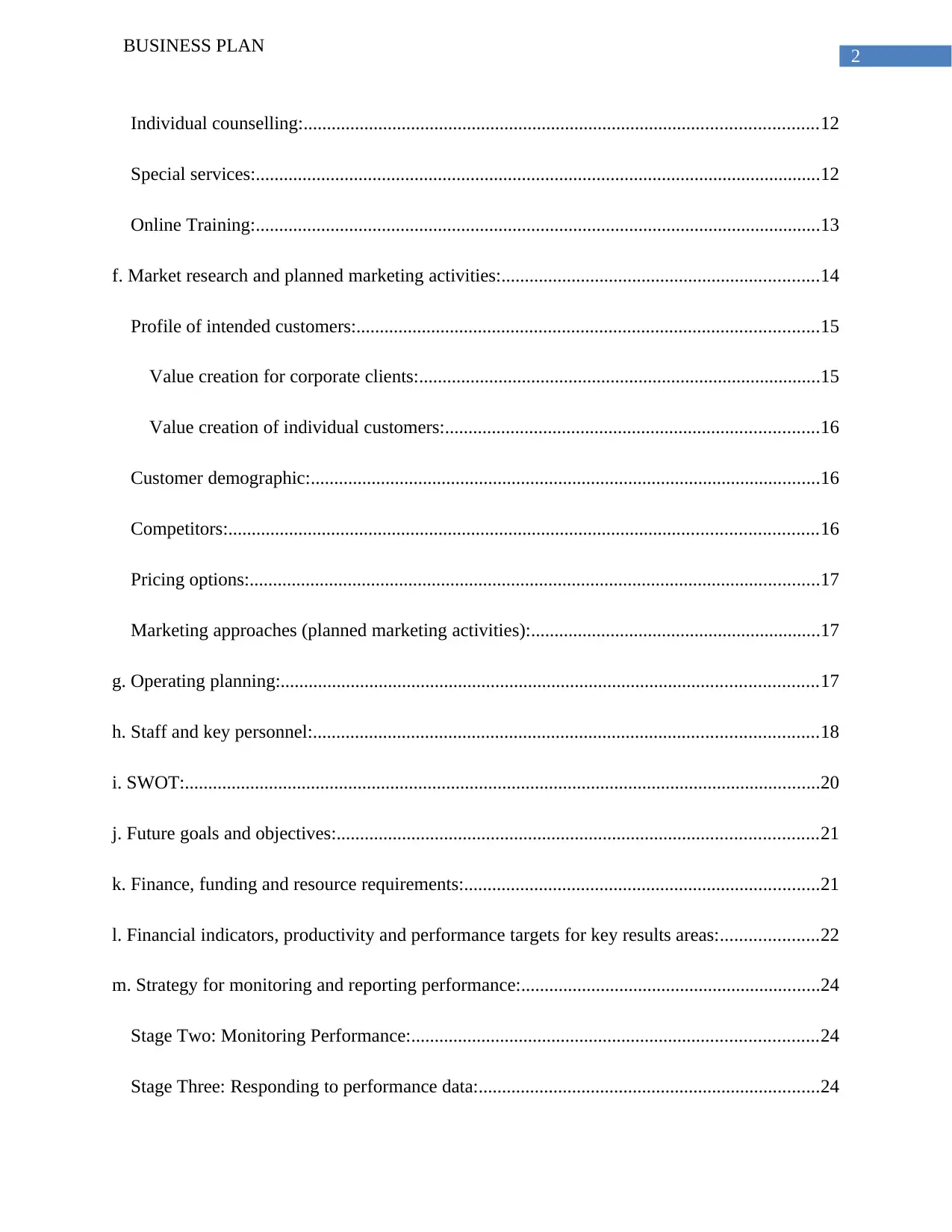
2
BUSINESS PLAN
Individual counselling:..............................................................................................................12
Special services:.........................................................................................................................12
Online Training:.........................................................................................................................13
f. Market research and planned marketing activities:....................................................................14
Profile of intended customers:...................................................................................................15
Value creation for corporate clients:......................................................................................15
Value creation of individual customers:................................................................................16
Customer demographic:.............................................................................................................16
Competitors:..............................................................................................................................16
Pricing options:..........................................................................................................................17
Marketing approaches (planned marketing activities):..............................................................17
g. Operating planning:...................................................................................................................17
h. Staff and key personnel:............................................................................................................18
i. SWOT:........................................................................................................................................20
j. Future goals and objectives:.......................................................................................................21
k. Finance, funding and resource requirements:............................................................................21
l. Financial indicators, productivity and performance targets for key results areas:.....................22
m. Strategy for monitoring and reporting performance:................................................................24
Stage Two: Monitoring Performance:.......................................................................................24
Stage Three: Responding to performance data:.........................................................................24
BUSINESS PLAN
Individual counselling:..............................................................................................................12
Special services:.........................................................................................................................12
Online Training:.........................................................................................................................13
f. Market research and planned marketing activities:....................................................................14
Profile of intended customers:...................................................................................................15
Value creation for corporate clients:......................................................................................15
Value creation of individual customers:................................................................................16
Customer demographic:.............................................................................................................16
Competitors:..............................................................................................................................16
Pricing options:..........................................................................................................................17
Marketing approaches (planned marketing activities):..............................................................17
g. Operating planning:...................................................................................................................17
h. Staff and key personnel:............................................................................................................18
i. SWOT:........................................................................................................................................20
j. Future goals and objectives:.......................................................................................................21
k. Finance, funding and resource requirements:............................................................................21
l. Financial indicators, productivity and performance targets for key results areas:.....................22
m. Strategy for monitoring and reporting performance:................................................................24
Stage Two: Monitoring Performance:.......................................................................................24
Stage Three: Responding to performance data:.........................................................................24
⊘ This is a preview!⊘
Do you want full access?
Subscribe today to unlock all pages.

Trusted by 1+ million students worldwide

3
BUSINESS PLAN
References:....................................................................................................................................25
BUSINESS PLAN
References:....................................................................................................................................25
Paraphrase This Document
Need a fresh take? Get an instant paraphrase of this document with our AI Paraphraser
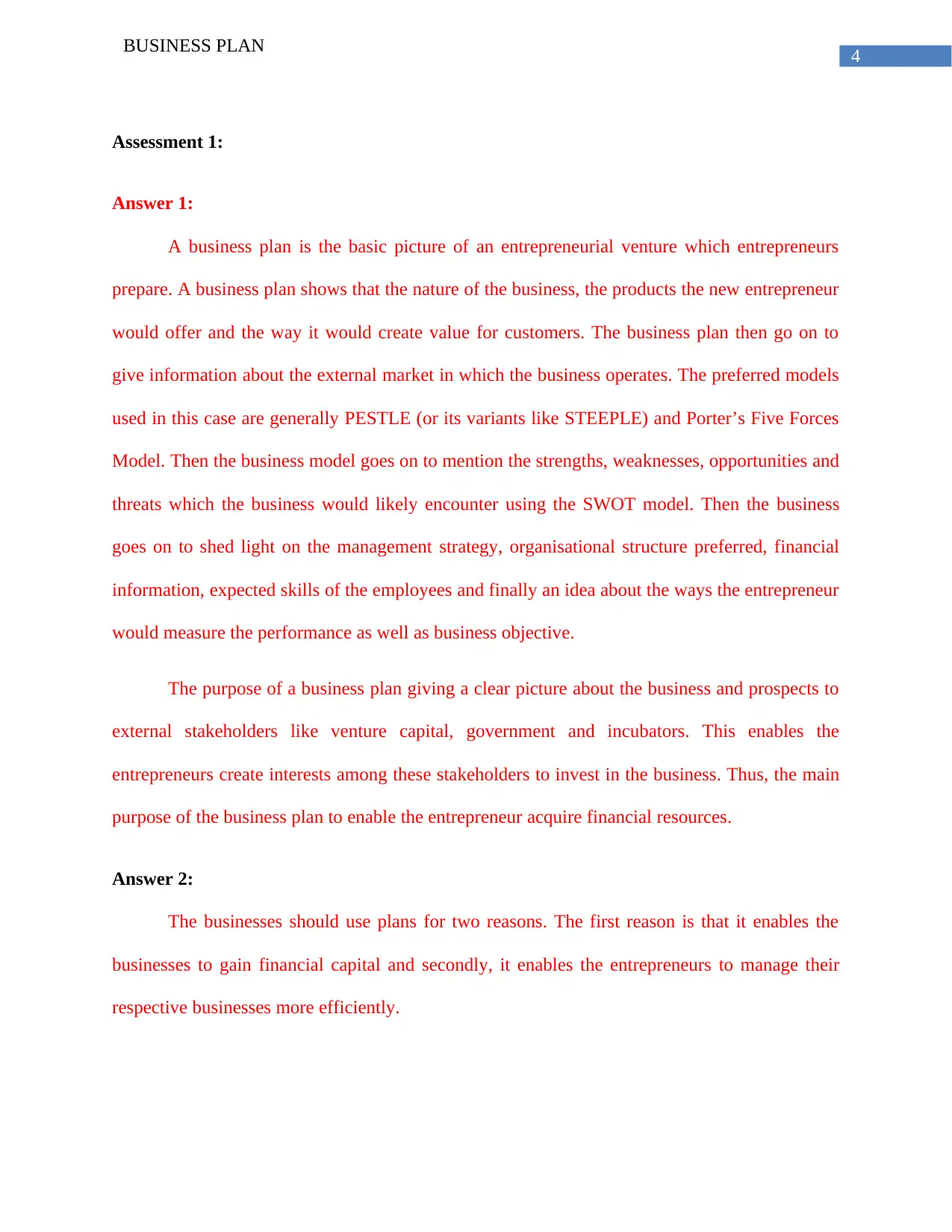
4
BUSINESS PLAN
Assessment 1:
Answer 1:
A business plan is the basic picture of an entrepreneurial venture which entrepreneurs
prepare. A business plan shows that the nature of the business, the products the new entrepreneur
would offer and the way it would create value for customers. The business plan then go on to
give information about the external market in which the business operates. The preferred models
used in this case are generally PESTLE (or its variants like STEEPLE) and Porter’s Five Forces
Model. Then the business model goes on to mention the strengths, weaknesses, opportunities and
threats which the business would likely encounter using the SWOT model. Then the business
goes on to shed light on the management strategy, organisational structure preferred, financial
information, expected skills of the employees and finally an idea about the ways the entrepreneur
would measure the performance as well as business objective.
The purpose of a business plan giving a clear picture about the business and prospects to
external stakeholders like venture capital, government and incubators. This enables the
entrepreneurs create interests among these stakeholders to invest in the business. Thus, the main
purpose of the business plan to enable the entrepreneur acquire financial resources.
Answer 2:
The businesses should use plans for two reasons. The first reason is that it enables the
businesses to gain financial capital and secondly, it enables the entrepreneurs to manage their
respective businesses more efficiently.
BUSINESS PLAN
Assessment 1:
Answer 1:
A business plan is the basic picture of an entrepreneurial venture which entrepreneurs
prepare. A business plan shows that the nature of the business, the products the new entrepreneur
would offer and the way it would create value for customers. The business plan then go on to
give information about the external market in which the business operates. The preferred models
used in this case are generally PESTLE (or its variants like STEEPLE) and Porter’s Five Forces
Model. Then the business model goes on to mention the strengths, weaknesses, opportunities and
threats which the business would likely encounter using the SWOT model. Then the business
goes on to shed light on the management strategy, organisational structure preferred, financial
information, expected skills of the employees and finally an idea about the ways the entrepreneur
would measure the performance as well as business objective.
The purpose of a business plan giving a clear picture about the business and prospects to
external stakeholders like venture capital, government and incubators. This enables the
entrepreneurs create interests among these stakeholders to invest in the business. Thus, the main
purpose of the business plan to enable the entrepreneur acquire financial resources.
Answer 2:
The businesses should use plans for two reasons. The first reason is that it enables the
businesses to gain financial capital and secondly, it enables the entrepreneurs to manage their
respective businesses more efficiently.

5
BUSINESS PLAN
Answer 3:
A business plan is used by a new venture whereas a strategic plan is used by an existing
venture. However, a business plan can also be used by an existing company while launching a
new business segment. Secondly, while a business plan covers several aspects like marketing,
management and financial aspects, the strategic plan may either cover all the aspects or specific
aspects like marketing.
Answer 4:
Section Description
Executive Summary The findings from the business plan.
Business summary The section reveals salient features of businesses like
their location, their prospective formats, their owners,
their prospective business goals, visions and missions.
This section also reveals about the products the
businesses would offer.
Management / operational
plan
This section speaks about the leadership structure of the
businesses. It also uncovers details about the decision
making mechanism that would be followed in the
businesses.
Market planning This section reveals about the marketing plan of the
entrepreneurial firms.
Future plans, vision, goals This section uncovers the business goals which the
BUSINESS PLAN
Answer 3:
A business plan is used by a new venture whereas a strategic plan is used by an existing
venture. However, a business plan can also be used by an existing company while launching a
new business segment. Secondly, while a business plan covers several aspects like marketing,
management and financial aspects, the strategic plan may either cover all the aspects or specific
aspects like marketing.
Answer 4:
Section Description
Executive Summary The findings from the business plan.
Business summary The section reveals salient features of businesses like
their location, their prospective formats, their owners,
their prospective business goals, visions and missions.
This section also reveals about the products the
businesses would offer.
Management / operational
plan
This section speaks about the leadership structure of the
businesses. It also uncovers details about the decision
making mechanism that would be followed in the
businesses.
Market planning This section reveals about the marketing plan of the
entrepreneurial firms.
Future plans, vision, goals This section uncovers the business goals which the
⊘ This is a preview!⊘
Do you want full access?
Subscribe today to unlock all pages.

Trusted by 1+ million students worldwide
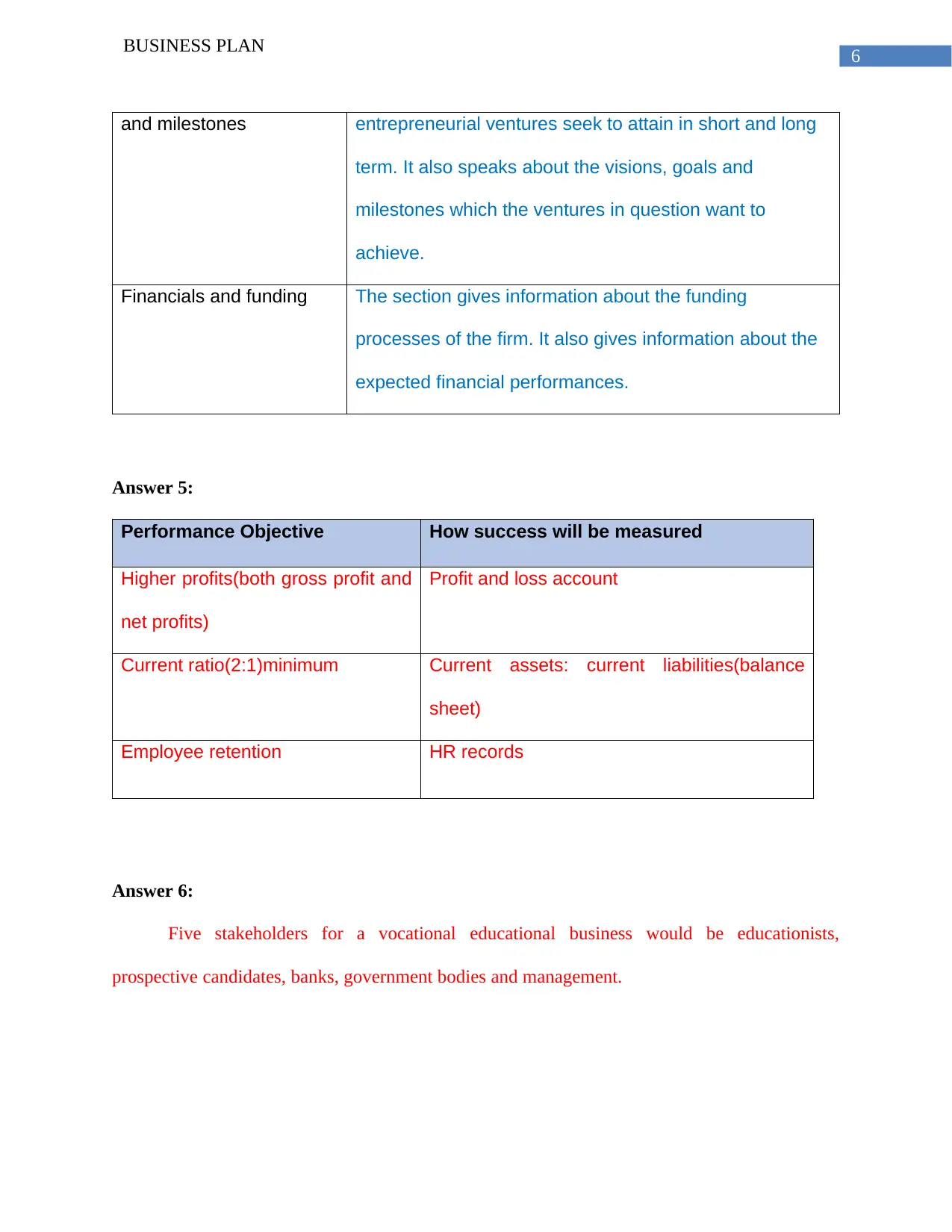
6
BUSINESS PLAN
and milestones entrepreneurial ventures seek to attain in short and long
term. It also speaks about the visions, goals and
milestones which the ventures in question want to
achieve.
Financials and funding The section gives information about the funding
processes of the firm. It also gives information about the
expected financial performances.
Answer 5:
Performance Objective How success will be measured
Higher profits(both gross profit and
net profits)
Profit and loss account
Current ratio(2:1)minimum Current assets: current liabilities(balance
sheet)
Employee retention HR records
Answer 6:
Five stakeholders for a vocational educational business would be educationists,
prospective candidates, banks, government bodies and management.
BUSINESS PLAN
and milestones entrepreneurial ventures seek to attain in short and long
term. It also speaks about the visions, goals and
milestones which the ventures in question want to
achieve.
Financials and funding The section gives information about the funding
processes of the firm. It also gives information about the
expected financial performances.
Answer 5:
Performance Objective How success will be measured
Higher profits(both gross profit and
net profits)
Profit and loss account
Current ratio(2:1)minimum Current assets: current liabilities(balance
sheet)
Employee retention HR records
Answer 6:
Five stakeholders for a vocational educational business would be educationists,
prospective candidates, banks, government bodies and management.
Paraphrase This Document
Need a fresh take? Get an instant paraphrase of this document with our AI Paraphraser
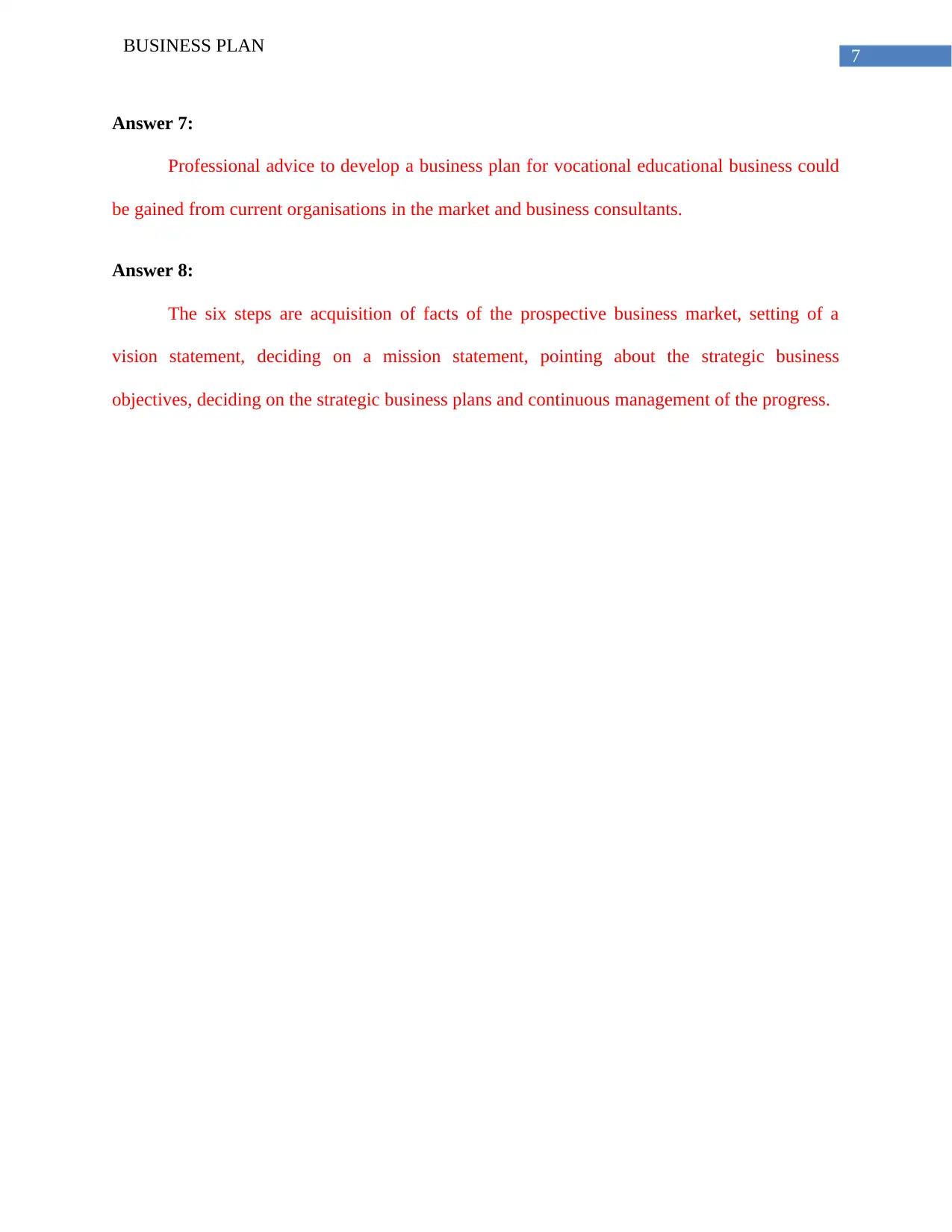
7
BUSINESS PLAN
Answer 7:
Professional advice to develop a business plan for vocational educational business could
be gained from current organisations in the market and business consultants.
Answer 8:
The six steps are acquisition of facts of the prospective business market, setting of a
vision statement, deciding on a mission statement, pointing about the strategic business
objectives, deciding on the strategic business plans and continuous management of the progress.
BUSINESS PLAN
Answer 7:
Professional advice to develop a business plan for vocational educational business could
be gained from current organisations in the market and business consultants.
Answer 8:
The six steps are acquisition of facts of the prospective business market, setting of a
vision statement, deciding on a mission statement, pointing about the strategic business
objectives, deciding on the strategic business plans and continuous management of the progress.
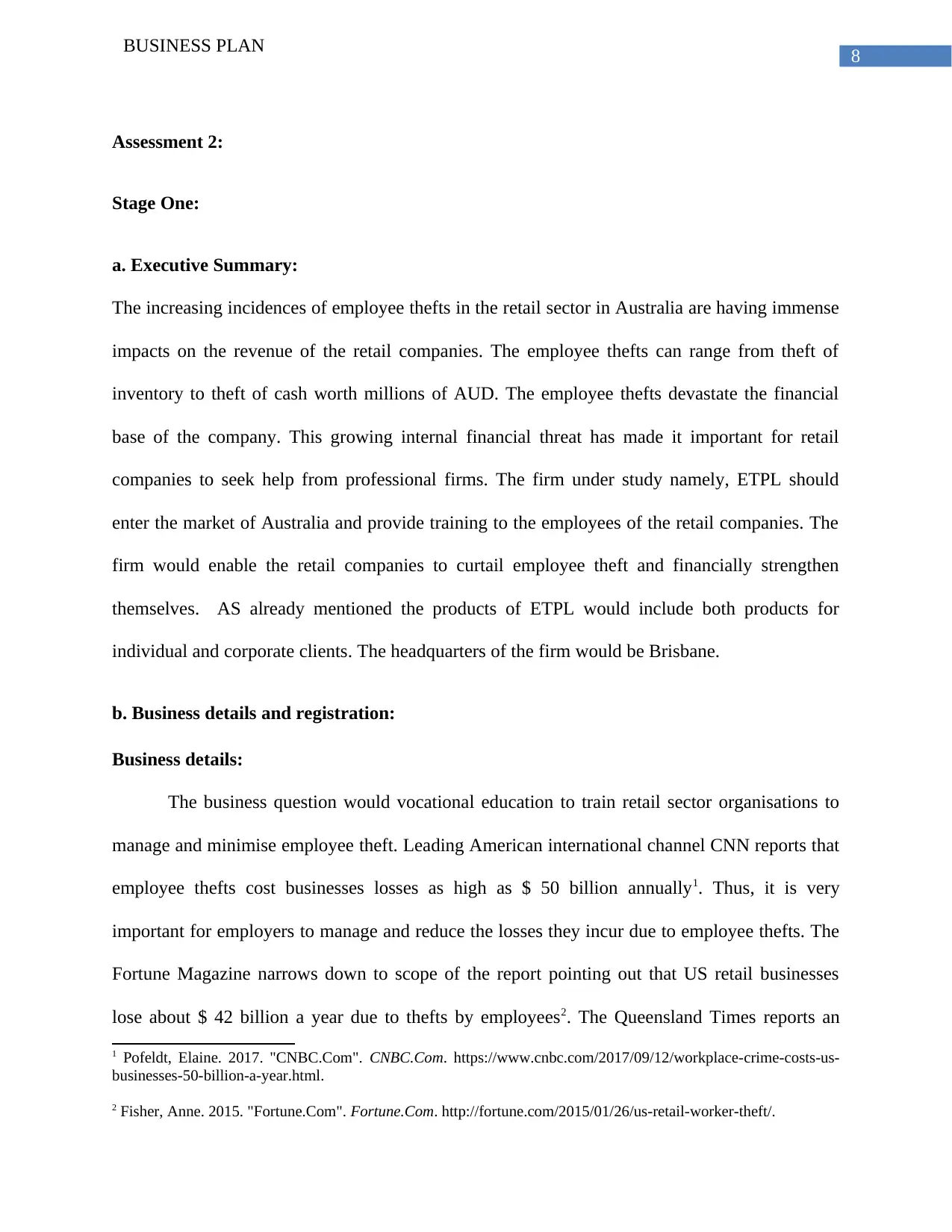
8
BUSINESS PLAN
Assessment 2:
Stage One:
a. Executive Summary:
The increasing incidences of employee thefts in the retail sector in Australia are having immense
impacts on the revenue of the retail companies. The employee thefts can range from theft of
inventory to theft of cash worth millions of AUD. The employee thefts devastate the financial
base of the company. This growing internal financial threat has made it important for retail
companies to seek help from professional firms. The firm under study namely, ETPL should
enter the market of Australia and provide training to the employees of the retail companies. The
firm would enable the retail companies to curtail employee theft and financially strengthen
themselves. AS already mentioned the products of ETPL would include both products for
individual and corporate clients. The headquarters of the firm would be Brisbane.
b. Business details and registration:
Business details:
The business question would vocational education to train retail sector organisations to
manage and minimise employee theft. Leading American international channel CNN reports that
employee thefts cost businesses losses as high as $ 50 billion annually1. Thus, it is very
important for employers to manage and reduce the losses they incur due to employee thefts. The
Fortune Magazine narrows down to scope of the report pointing out that US retail businesses
lose about $ 42 billion a year due to thefts by employees2. The Queensland Times reports an
1 Pofeldt, Elaine. 2017. "CNBC.Com". CNBC.Com. https://www.cnbc.com/2017/09/12/workplace-crime-costs-us-
businesses-50-billion-a-year.html.
2 Fisher, Anne. 2015. "Fortune.Com". Fortune.Com. http://fortune.com/2015/01/26/us-retail-worker-theft/.
BUSINESS PLAN
Assessment 2:
Stage One:
a. Executive Summary:
The increasing incidences of employee thefts in the retail sector in Australia are having immense
impacts on the revenue of the retail companies. The employee thefts can range from theft of
inventory to theft of cash worth millions of AUD. The employee thefts devastate the financial
base of the company. This growing internal financial threat has made it important for retail
companies to seek help from professional firms. The firm under study namely, ETPL should
enter the market of Australia and provide training to the employees of the retail companies. The
firm would enable the retail companies to curtail employee theft and financially strengthen
themselves. AS already mentioned the products of ETPL would include both products for
individual and corporate clients. The headquarters of the firm would be Brisbane.
b. Business details and registration:
Business details:
The business question would vocational education to train retail sector organisations to
manage and minimise employee theft. Leading American international channel CNN reports that
employee thefts cost businesses losses as high as $ 50 billion annually1. Thus, it is very
important for employers to manage and reduce the losses they incur due to employee thefts. The
Fortune Magazine narrows down to scope of the report pointing out that US retail businesses
lose about $ 42 billion a year due to thefts by employees2. The Queensland Times reports an
1 Pofeldt, Elaine. 2017. "CNBC.Com". CNBC.Com. https://www.cnbc.com/2017/09/12/workplace-crime-costs-us-
businesses-50-billion-a-year.html.
2 Fisher, Anne. 2015. "Fortune.Com". Fortune.Com. http://fortune.com/2015/01/26/us-retail-worker-theft/.
⊘ This is a preview!⊘
Do you want full access?
Subscribe today to unlock all pages.

Trusted by 1+ million students worldwide

9
BUSINESS PLAN
employee stealing gift vouchers worth $ 3500 intended for tenured employees3. Thus, it can be
pointed out that employee thefts are serious issues retail sector companies. Australia being the
headquarters to leading international retail chains like Woolworths is experiencing a boom in its
retail sector. However, in the light of the three aforementioned articles it can be pointed out that
employee thefts would have serious implications on the retail businesses both in terms of
financial position and goodwill. The retail organisations in Australia do have methods to deal
with inappropriate employee conducts like offering ethical training4 . However, it is clear from
the news reports that there exists a huge gap between the actual employee supervision methods
in the present retail organisations in Australia which is giving ways to employee thefts. The new
business organisation aim to provide vocational education to business heads working with retail
organisations to train them to controlling employee thefts. The name of the organisation would
be Ethical Training Proprietary Limited or ETPL. The company would be based in
Brisbane, Queensland and listed on ASX5.
Registration:
Ethical Training Proprietary Limited would be registered using the Business Registration
Services or BRS which is provided by the Australian Government. The company would be given
Australian Business Number or ABN by Australian Securities and Investment
Commission6.
3 Cowen. 2015. "Qt.Com.Au". Qt.Com.Au. https://www.qt.com.au/news/woolworths-pa-pockets-vouchers/2542687/.
4 Bonner, Julena M., Rebecca L. Greenbaum, and David M. Mayer. "My boss is morally disengaged: The role of
ethical leadership in explaining the interactive effect of supervisor and employee moral disengagement on employee
behaviors." Journal of Business Ethics 137, no. 4 (2016): 731-742.
5 "Asx.Com.Au". 2019. Asx.Com.Au. https://www.asx.com.au/.
6 "Asic.Gov.Au". 2019. Asic.Gov.Au. https://asic.gov.au/for-business/registering-a-company/steps-to-register-a-
company/.
BUSINESS PLAN
employee stealing gift vouchers worth $ 3500 intended for tenured employees3. Thus, it can be
pointed out that employee thefts are serious issues retail sector companies. Australia being the
headquarters to leading international retail chains like Woolworths is experiencing a boom in its
retail sector. However, in the light of the three aforementioned articles it can be pointed out that
employee thefts would have serious implications on the retail businesses both in terms of
financial position and goodwill. The retail organisations in Australia do have methods to deal
with inappropriate employee conducts like offering ethical training4 . However, it is clear from
the news reports that there exists a huge gap between the actual employee supervision methods
in the present retail organisations in Australia which is giving ways to employee thefts. The new
business organisation aim to provide vocational education to business heads working with retail
organisations to train them to controlling employee thefts. The name of the organisation would
be Ethical Training Proprietary Limited or ETPL. The company would be based in
Brisbane, Queensland and listed on ASX5.
Registration:
Ethical Training Proprietary Limited would be registered using the Business Registration
Services or BRS which is provided by the Australian Government. The company would be given
Australian Business Number or ABN by Australian Securities and Investment
Commission6.
3 Cowen. 2015. "Qt.Com.Au". Qt.Com.Au. https://www.qt.com.au/news/woolworths-pa-pockets-vouchers/2542687/.
4 Bonner, Julena M., Rebecca L. Greenbaum, and David M. Mayer. "My boss is morally disengaged: The role of
ethical leadership in explaining the interactive effect of supervisor and employee moral disengagement on employee
behaviors." Journal of Business Ethics 137, no. 4 (2016): 731-742.
5 "Asx.Com.Au". 2019. Asx.Com.Au. https://www.asx.com.au/.
6 "Asic.Gov.Au". 2019. Asic.Gov.Au. https://asic.gov.au/for-business/registering-a-company/steps-to-register-a-
company/.
Paraphrase This Document
Need a fresh take? Get an instant paraphrase of this document with our AI Paraphraser
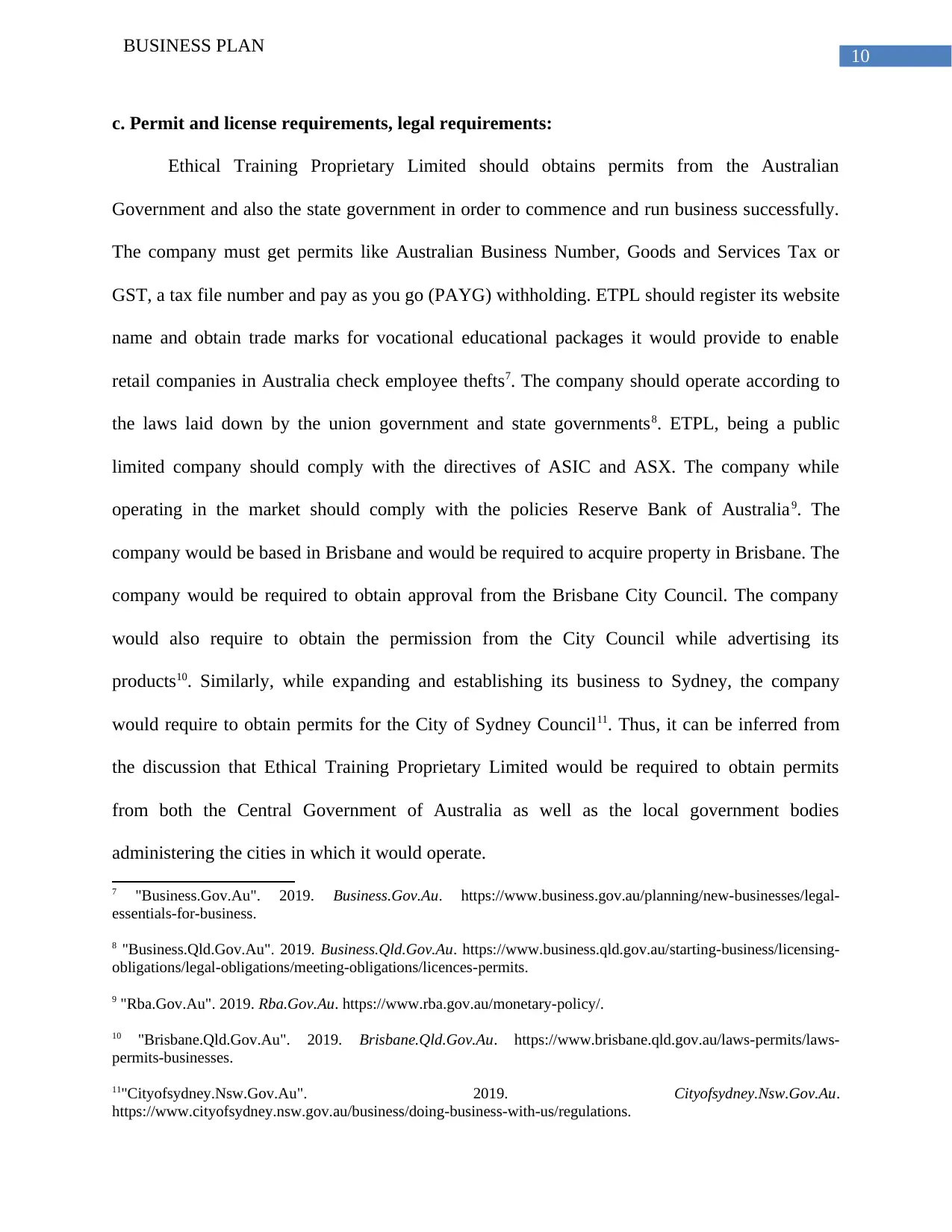
10
BUSINESS PLAN
c. Permit and license requirements, legal requirements:
Ethical Training Proprietary Limited should obtains permits from the Australian
Government and also the state government in order to commence and run business successfully.
The company must get permits like Australian Business Number, Goods and Services Tax or
GST, a tax file number and pay as you go (PAYG) withholding. ETPL should register its website
name and obtain trade marks for vocational educational packages it would provide to enable
retail companies in Australia check employee thefts7. The company should operate according to
the laws laid down by the union government and state governments8. ETPL, being a public
limited company should comply with the directives of ASIC and ASX. The company while
operating in the market should comply with the policies Reserve Bank of Australia9. The
company would be based in Brisbane and would be required to acquire property in Brisbane. The
company would be required to obtain approval from the Brisbane City Council. The company
would also require to obtain the permission from the City Council while advertising its
products10. Similarly, while expanding and establishing its business to Sydney, the company
would require to obtain permits for the City of Sydney Council11. Thus, it can be inferred from
the discussion that Ethical Training Proprietary Limited would be required to obtain permits
from both the Central Government of Australia as well as the local government bodies
administering the cities in which it would operate.
7 "Business.Gov.Au". 2019. Business.Gov.Au. https://www.business.gov.au/planning/new-businesses/legal-
essentials-for-business.
8 "Business.Qld.Gov.Au". 2019. Business.Qld.Gov.Au. https://www.business.qld.gov.au/starting-business/licensing-
obligations/legal-obligations/meeting-obligations/licences-permits.
9 "Rba.Gov.Au". 2019. Rba.Gov.Au. https://www.rba.gov.au/monetary-policy/.
10 "Brisbane.Qld.Gov.Au". 2019. Brisbane.Qld.Gov.Au. https://www.brisbane.qld.gov.au/laws-permits/laws-
permits-businesses.
11"Cityofsydney.Nsw.Gov.Au". 2019. Cityofsydney.Nsw.Gov.Au.
https://www.cityofsydney.nsw.gov.au/business/doing-business-with-us/regulations.
BUSINESS PLAN
c. Permit and license requirements, legal requirements:
Ethical Training Proprietary Limited should obtains permits from the Australian
Government and also the state government in order to commence and run business successfully.
The company must get permits like Australian Business Number, Goods and Services Tax or
GST, a tax file number and pay as you go (PAYG) withholding. ETPL should register its website
name and obtain trade marks for vocational educational packages it would provide to enable
retail companies in Australia check employee thefts7. The company should operate according to
the laws laid down by the union government and state governments8. ETPL, being a public
limited company should comply with the directives of ASIC and ASX. The company while
operating in the market should comply with the policies Reserve Bank of Australia9. The
company would be based in Brisbane and would be required to acquire property in Brisbane. The
company would be required to obtain approval from the Brisbane City Council. The company
would also require to obtain the permission from the City Council while advertising its
products10. Similarly, while expanding and establishing its business to Sydney, the company
would require to obtain permits for the City of Sydney Council11. Thus, it can be inferred from
the discussion that Ethical Training Proprietary Limited would be required to obtain permits
from both the Central Government of Australia as well as the local government bodies
administering the cities in which it would operate.
7 "Business.Gov.Au". 2019. Business.Gov.Au. https://www.business.gov.au/planning/new-businesses/legal-
essentials-for-business.
8 "Business.Qld.Gov.Au". 2019. Business.Qld.Gov.Au. https://www.business.qld.gov.au/starting-business/licensing-
obligations/legal-obligations/meeting-obligations/licences-permits.
9 "Rba.Gov.Au". 2019. Rba.Gov.Au. https://www.rba.gov.au/monetary-policy/.
10 "Brisbane.Qld.Gov.Au". 2019. Brisbane.Qld.Gov.Au. https://www.brisbane.qld.gov.au/laws-permits/laws-
permits-businesses.
11"Cityofsydney.Nsw.Gov.Au". 2019. Cityofsydney.Nsw.Gov.Au.
https://www.cityofsydney.nsw.gov.au/business/doing-business-with-us/regulations.

11
BUSINESS PLAN
d. Business premises, location:
The company would acquire its own property to establish its headquarters in Brisbane.
The company would also expand its operations to other top Australian cities like Sydney,
Canberra and Adelaide as a part of its three years business strategy. Ethical Training Proprietary
Limited would also expand into other countries like New Zealand as a part of its five year plans.
e. Product and services:
The products and services which Ethical Training Proprietary Limited would provide
would consist of corporate training packages, individual training packages and special services.
The product line of ETPL would aim to place the company at the top positions in the business
counselling market in Australia. The following are the details of the products and services which
ETPL would offer to its clients:
Corporate Training Packages:
The corporate training packages would aim to benefit the retail companies which are
operating in Australia. The corporate training packages would be available in four variants
according to the needs of the companies. The small scale package would be designed for the
small scale industries in Australia and would cost AUD 10000 per package. The medium scale
package would be designed to meet the requirements of the medium scale companies and would
cost AUD 20000. The large scale package would be designed to meet the employee training
requirements of large scale multinational retail companies and would cost around AUD 50000.
The startup package would aim to provide ethical training to employees of start-up companies.
The cost of a single start-up training package would cost around AUD 1000. The cost of start-up
training package has been kept lowest of the four considering the limited financial resources of
the start-up businesses. However, it should be noted that if a start-up is a subsidiary of another
BUSINESS PLAN
d. Business premises, location:
The company would acquire its own property to establish its headquarters in Brisbane.
The company would also expand its operations to other top Australian cities like Sydney,
Canberra and Adelaide as a part of its three years business strategy. Ethical Training Proprietary
Limited would also expand into other countries like New Zealand as a part of its five year plans.
e. Product and services:
The products and services which Ethical Training Proprietary Limited would provide
would consist of corporate training packages, individual training packages and special services.
The product line of ETPL would aim to place the company at the top positions in the business
counselling market in Australia. The following are the details of the products and services which
ETPL would offer to its clients:
Corporate Training Packages:
The corporate training packages would aim to benefit the retail companies which are
operating in Australia. The corporate training packages would be available in four variants
according to the needs of the companies. The small scale package would be designed for the
small scale industries in Australia and would cost AUD 10000 per package. The medium scale
package would be designed to meet the requirements of the medium scale companies and would
cost AUD 20000. The large scale package would be designed to meet the employee training
requirements of large scale multinational retail companies and would cost around AUD 50000.
The startup package would aim to provide ethical training to employees of start-up companies.
The cost of a single start-up training package would cost around AUD 1000. The cost of start-up
training package has been kept lowest of the four considering the limited financial resources of
the start-up businesses. However, it should be noted that if a start-up is a subsidiary of another
⊘ This is a preview!⊘
Do you want full access?
Subscribe today to unlock all pages.

Trusted by 1+ million students worldwide
1 out of 27
Related Documents
Your All-in-One AI-Powered Toolkit for Academic Success.
+13062052269
info@desklib.com
Available 24*7 on WhatsApp / Email
![[object Object]](/_next/static/media/star-bottom.7253800d.svg)
Unlock your academic potential
Copyright © 2020–2025 A2Z Services. All Rights Reserved. Developed and managed by ZUCOL.





